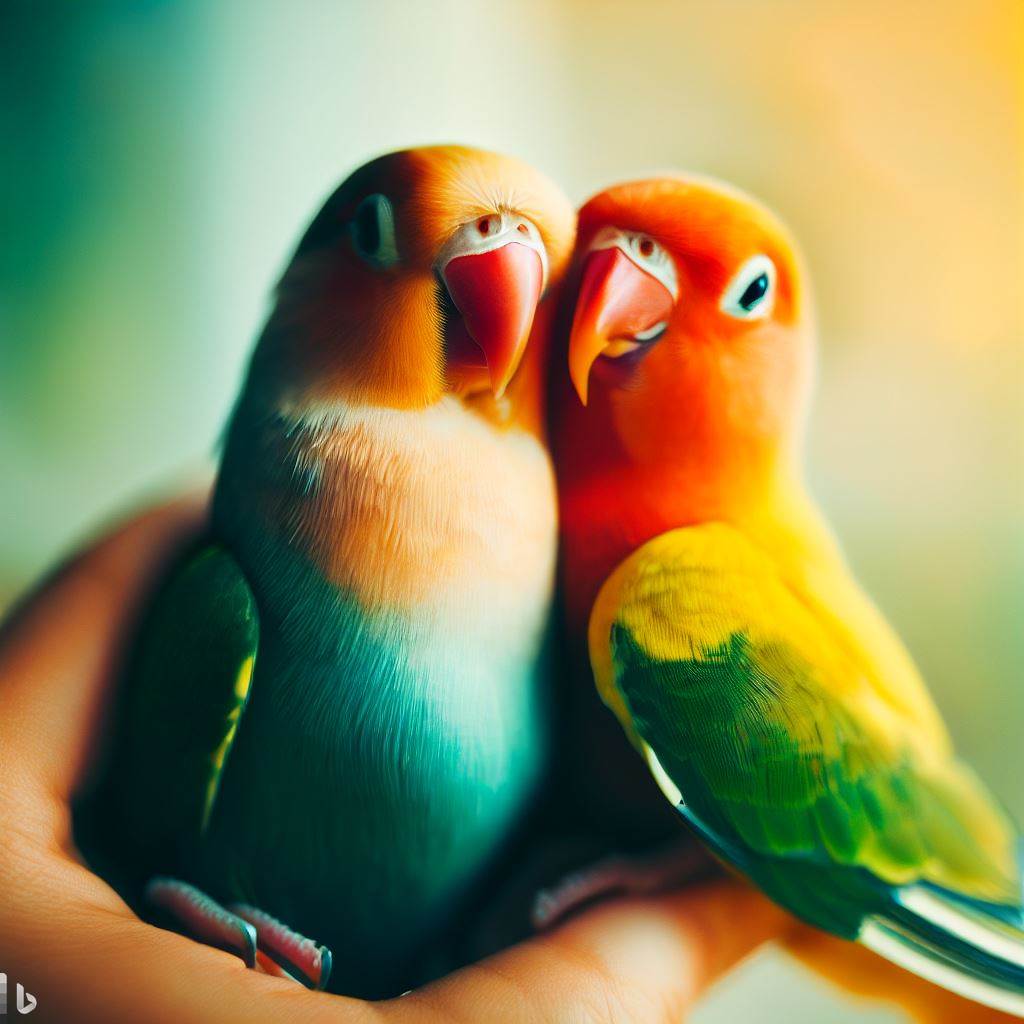There are nine different species of lovebirds from the genus Agapornis. All but one, the Madagascar, originate in Africa. The Madagascar is indigenous to the same. The species are listed below:
COMMON
- Peachfaced – Agapornis roseicollis
- Masked – Agapornis personata personata
- Fischer’s – Agapornis personata fischeri
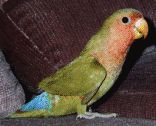 | 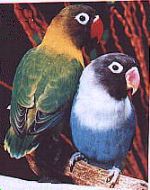 | 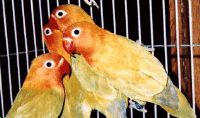 |
RARE
- Nyasa Agapornis – lilianae
- Madagascar – Agapornis cana
- Abyssinian – Agapornis taranta
- Redfaced – Agapornis pullaria
- Black Collared – Agapornis Swindernia
- Blackcheeked – Agapornis personata nigrigensis
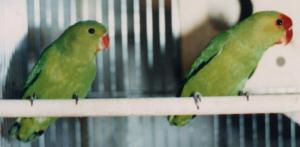 | |
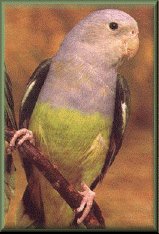 | 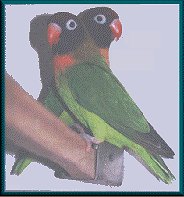 |
Three of the nine species, including the Madagascar, Redfaced, and Abyssinian, are sexually dimorphic. Dimorphic simply means sexing can be accomplished visually.
Four of the nine species are from the Eye Ring group, having a white ring surrounding the eyes. They are Fischer’s, Nyasa, Black-cheeked, and Masked. It is said all Eye Rings make excellent foster parents for other Eye Rings. The Peachfaced and Black-collared are in the Non Eye Ring group.
Sizes range from 4″, as in the Fischer’s, to 7″, as in the Peachfaced. Weights generally range from 50-60 grams and females tend to be larger than the males, and for the most part, more aggressive as well.
Lovebirds are beautiful displays of color; blue, yellow, olive, orange, and grey. Only the budgerigar comes in a wider array of colors. There are 17 Peachfaced mutations alone, allowing well over 100,000 color mutations.
PERSONALITY AND CHARACTERISTICS
It is recommended you do not house a lovebird alone. Indicative of their name, they regard each other with deep fondness and affection. They show an especially intenseurge for bonding. It is a characteristic deeply imbedded in them. They will even bond to their same sex.
It is important for lovebirds to give each other, and receive, constant assurance and acknowledgement. These needs are satisfied by frequent contact, as in kissing and preening, or may come in a more serious manner, such as painful nips and bites.
Lovebirds are prone to loud, vocal outbursts. These usually are during times of alarm or excitement. Although they are not singers, their chirps, squeals, and chortles, make a music of their own. They dearly love to chatter and talk amongst themselves. If your desire is for a quiet bird, lovebirds are definitely not for you!
Without doubt, I hear my two lovebirds talk. They say one word, or phrase, in quick repitition. Morning feeding time is deemed our “quality time” together. I talk and babble on, all the while commanding gently, “Up, up!” This is to help me clean and feed without hassle while they are “up” and out of the way. While the enunciation of the words are unclear, the tone and rythm are as my own.
I believe most any bird can be taught to talk with enough patience and perseverance. However, it does not make or break the birds personality. A lovebird who willl never utter a word or phrase, has the full capacity to give joy and live an enriched, purposeful life.
HOUSING AND MAINTENANCE
Your lovebird should not be housed alone. Your lovebird pair should be housed in a cage with dimensions no less than 18x18x12″. Bar spacing should be no more than 3/4″. This size will ensure plenty of space to fly and flitter about, and if so desired, the freedom of each bird from each other. Birds need “personal space” too!
Round cages are not recommended for they offer no place for them to “hide”. Square cages provide corners for a bird to face into, resulting in a feeling of invisibility, safety, and security.
Cage cleaning should be done daily, complete disinfecting on a weekly basis. This includes food/water dishes as well. Water dishes accumulate bacteria at an alarming rate. This could promote illness in your bird.
Cleanliness of a cage is a top priority for the health of your lovebird. In the wild, birds do not come in direct contact with their droppings. Birds excrete between 25-50 times per day, depending on size. A brooding female will excrete out of the nest, and chicks in the nest instinctively wriggle up and back, out of the nest to excrete. Don’t give your lovebird an opportunity to come into contact with droppings. Place food and water strategically out of the way of droppings.
Offer perches of various shapes and widths, not standard round wooden ones. These will keep the feet from developmental problems. When perches of wood are wet from cleaning, be sure to sun-dry thoroughly.
When cleaning and/or disinfecting the cage, perch or any accessory, be sure you rinse all residue from cleaning and disinfecting agents. Your lovebird’s respiratory system is 70 times greater[Pat do you mean size, sensitivity or volume of air passing through – conused] than our own. Even a slight odor or vapor can produce disastrous results.
Toys are an absolute must to keep your bird mentally stimulated and physically active. Lovebirds are particularly fond of playing, and will spend much time devoted to this activity. Bird toys found in pet stores can be pricey. To ease the financial burden do some toy shopping in the kids’ toy section of a grocery store. I have purchased neon-colored (they’re made for kids, so they’re safe!) cowboys and Indians and large, plastic jacks for little girls. A clean plastic top off a gallon milk jug is good, too. Some cat toys, which are priced better, can also be used. I also make good use out of little girls’ hair barrettes. They come in fun shapes, sizes, and every color imaginable. Keep your eyes open and your imagination tuned, and you will see all kinds of toys. It’s fun to see how creative and ingenious you can be with toys! To keep interest at it’s peak, rotate toys regularly.
GROOMING
Grooming is an essential part of maintenance for any bird. This generally includes wings, nails, and if required, the filing of an overgrown hookbill. When more than one lovebird is housed together, the wings should not be trimmed. Most assuredly there will be instances where one bird will need to quickly fly away and escape a threat another bird may impose. Full flighted wings assure a quick get away from harm.
Nails should be trimmed every six weeks or so. Nails which are overgrown inhibit proper perching and can be painful when digging into the feet. Overgrown nails are easily caught and could result in loss of a toe, or even bleeding to death. A bird can bleed to death in a matter of minutes. Only an experienced bird groomer should groom your bird.
Hookbills can become overgorwn to the point of interfering with eating. They are filed quickly and painlessly.
Bathing is part of grooming also. If no source of bathing water is supplied, you may find your birds splashing happily in the drinking water. This is unsanitary and should be avoided by making a dish of water available a few times a week. Some enjoy misting in addition to, or as opposed to bathing. Lovebirds love to bathe and this activity is worth watching and observing. There will be splashing and dipping amidst squeels of delight!
DIET AND NUTRITION
Feeding lovebirds a nutritionally dense diet is essential in maintaining optimum health. A seed-only diet most assuredly will result in disease, and more likely, a shortened life span. A lovebird’s life span is between 15-20 years. For complete, proper nutrition, a base diet is highly recommended. A base diet is just what it implies-a base upon which to build on and around. A sound base diet will be the major source of nutrition, being supplied in a whole-food source. The recipe below is a prime example of a proper base diet.
Yummy! Rice Mixture
2 1/2 c whole grain brown rice
1 bag 16 bean mix (legumes)
1 c pearl barley
1 c uncooked elbow macaroni
2 pkgs ramen noodles (no seasoning)
9 c uncooked frozen mixed veggies
2/3 c granulated sea kelp (found in health food stores)
Bring 5 c water to boil, add rice. Cover and simmer for 45 min. Pour 16 bean mix in large stew pot and completely cover with water. Bring to boil; boil for 40 min., or until tender. Cook pearl barley in 2 c water until water is completely absorbed. Boil macaroni for 7 min. Break up ramen noodles, add to boiling macaroni for 3 min more. Drain and rinse.
Put above cooked ingredients in large tub or container. Add uncooked Frozen veggies. Sprinkly 2/3 c sea delp on veggies. Stir and mix thoroughly. Freeze until ready to use.
Along with serving the rice mixture, fruit, greens, and a type of whole grain should also be offered daily. Apple is a favorite fruit because it contains pectin, which levels blood sugar and helps eliminate cholesterol. Before serving any produce purchased, wash thoroughly!
Sources of whole grain are cereals, toast, or crackers. (Beware of sodium content in crackers, however!) Cheerios make an excellent addition nutritionally, and visually it intrigues a hungry bird into trying something they are unsure of.
Cuttlebone and mineral block are made available at all times. A conditioning, or egg food, is also made available, and as a treat, spray millet.
BREEDING
When housing more than one lovebird, you may find yourself with a pair which will breed. This is why having an unrelated pair is so crucial. Lovebirds are prolific and can become seriously ill if allowed to continue all year round. As with nature, they should not be allowed to breed after two clutches.
Clutches are usually between 4-6 eggs, with incubation at 21-26 days. Good nesting material to offer is palm fronds and brances of willow and fruit trees. Pine shavings are put in the nest box as well.
The female is the primary nest builder and completes the task in about 4-5 days. After carefully shredding the material, she will take it piece by piece and tuck it into her back and tail feathers, then flying to the nest to build. She will brood her clutch with painful dedication, leaving only to excrete, drink and have a bit of food. Her mate will feed her for the most part, by regurgitating.
A breeding pair of lovebirds require dense, nutrition packed food sources. The severity of physical stress demands need to be compensated with vitamins, protein, iodine, calcium, and minerals. The before listed base diet, is an excellent breeding food for it is easily assimilated and regurgitated both to the female, and later on, the babies. Babies are normally fully weaned at 6-8 weeks of age.

